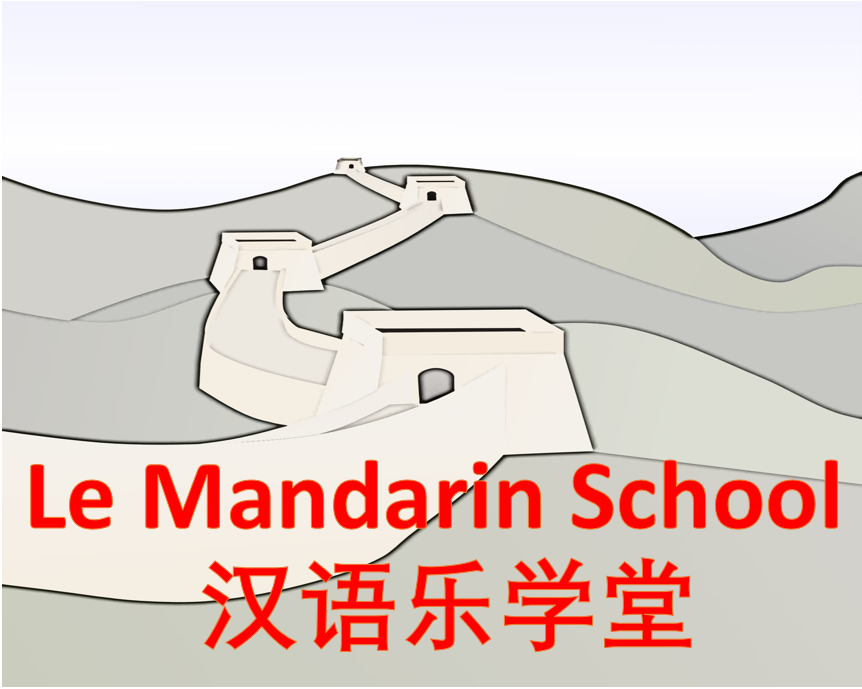Course Information
- Before signing up for any course, it is recommended that a potential student should do the following :
- Try the free lesson 1 trial of every course (except BCMIP2 which is a continuation of BCMIP1) to understand the course itself and the Learning Management System. You have to register for the free trial, just go to the Contact LMS page to send an email to indicate interest and the School will liaise with you to complete the registration.
- Email the instructor David Tan for any inquires at the Contact LMS page.
- When you decide to enroll in one of the courses, you should register yourself so as to be able to access the website. Go to the Contact LMS page to send an email to indicate interest and the School will liaise with you to complete the registration. Once registered, go to the “Available Courses” section on the home page and click on the “Order” button to initiate the payment process.
- For Singapore-based student, you can pay the course fee in SGD via Internet Banking/PayNow to save on the currency conversion fee. For details, please see the section “How do I pay?” on the Course Info and FAQ page.
- For students who are not based in Singapore, you can use Paypal to pay the course fee in USD or Euro.
- After you have paid for the course, please allow some time for the financial institution to process the payment. There is also the administration process of granting the course’s access to the student.
- You will be informed that you can commence course via an email from the school.
- Note that once you have completed the final lesson and so being awarded the course certificate, it is deemed that you have completed the course and your access will expire.
Privacy
- The Privacy Policy of this website uses the EU’s General Data Protection Regulation (GDPR) framework as a reference for best practices.
Security
- Some of the policies/tools this website uses to enhance its overall security:
- Auto-lockout after FIVE unsuccessful login attempts
- Using secure version of HTTP i.e. HTTPS. You can see the padlock icon on the URL address bar
- Implemented Google reCAPTCHA which is a security service that protects LeMS website from illegal login
- Incorporated some rules in the Firewall for protection against attackers
- The courses are usually conducted in English and the student just needs to have basic grammar knowledge such as an understanding of noun, verb, adjective etc.
- The student does not need to be IT savvy to do the e-learning course as it is very intuitive. There is a detailed student guide to help the students in using the e-learning software. The only requirement is that for oral quiz, the student is expected to record an MP3 file for his/her answer and upload it into the system. To record an MP3 file, the student can use the recorder app in his/her mobile phone.
Course Methodology
This class adopts a structured pedagogy that ensures a student has learnt the essentials in a lesson first before being allowed to proceed to the next lesson. Hence in order to progress, the student must pass the quizzes first. It also boasts of a social learning element as the instructor and the students can interact with each other in a virtual environment.
For every lesson, there is a 40-minute video call for revision purpose before the final quiz.
BCMIP
There are topics and quizzes for every lesson.
BCMIP1 are fundamental lessons in Pinyin and it also has an introduction on grammar. BCMIP2 focuses on vocabulary building, grammar understanding and their application in daily situations. Lesson 9 serves as a revision lesson and pointers for future learning .
Generally, lesson 3 of BCMIP1 and BCMIP2 have the below structure:
- Vocabulary for that lesson. Students will learn the pronunciation and the meanings of the vocabulary, followed by a practice session.
- The students will be taught the application in the various topics and there are quizzes at the end of each topic to evaluate the student’s understanding.
- There is a final quiz at the end of every lesson which could include the following:
- Summary Quiz. Students are to select one correct answer or multiple correct answers in the multiple-choice questions. The quiz includes listening comprehension questions.
- Listening Comprehension. Students are to key in the Pinyin of an audio file by listening.
- Written Pinyin. Filling in blank with appropriate Pinyin in a sentence.
- Graded Questions. The questions here will be graded by the Instructor. Students will be tested for their pronunciation, understanding of the pinyin sentence via translation into English, and general understanding of grammar and vocabulary through sentence constructing.
BUOCC
BUOCC has quizzes to test the student’s understanding of written characters.
- The Course Instructor will be actively engaging with the students along the way via electronic means such as chat room, messaging, group forums, blog articles, activity feed etc.
- He will also monitor the student’s progress via the below reporting tool and so he is able to proactively manage the student’s progress during the duration of the course. In so doing, the instructor is able to spend his time effectively to focus on the student’s learning issues.
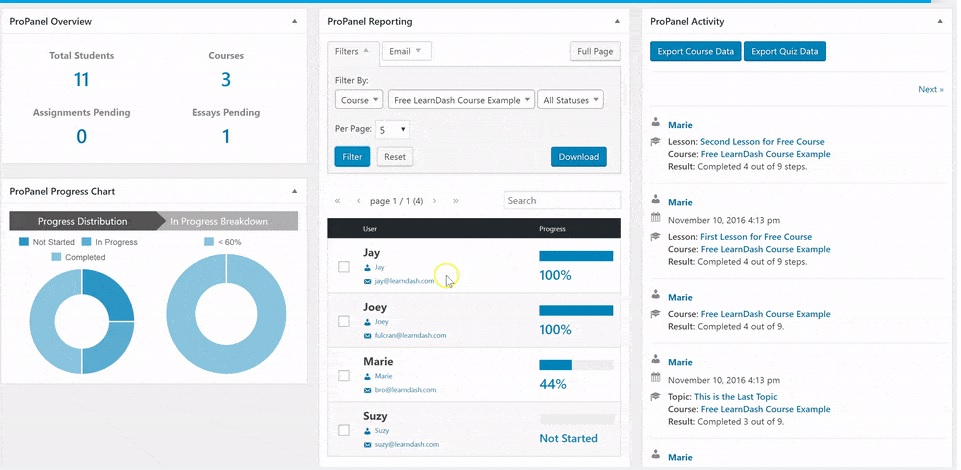
FAQ
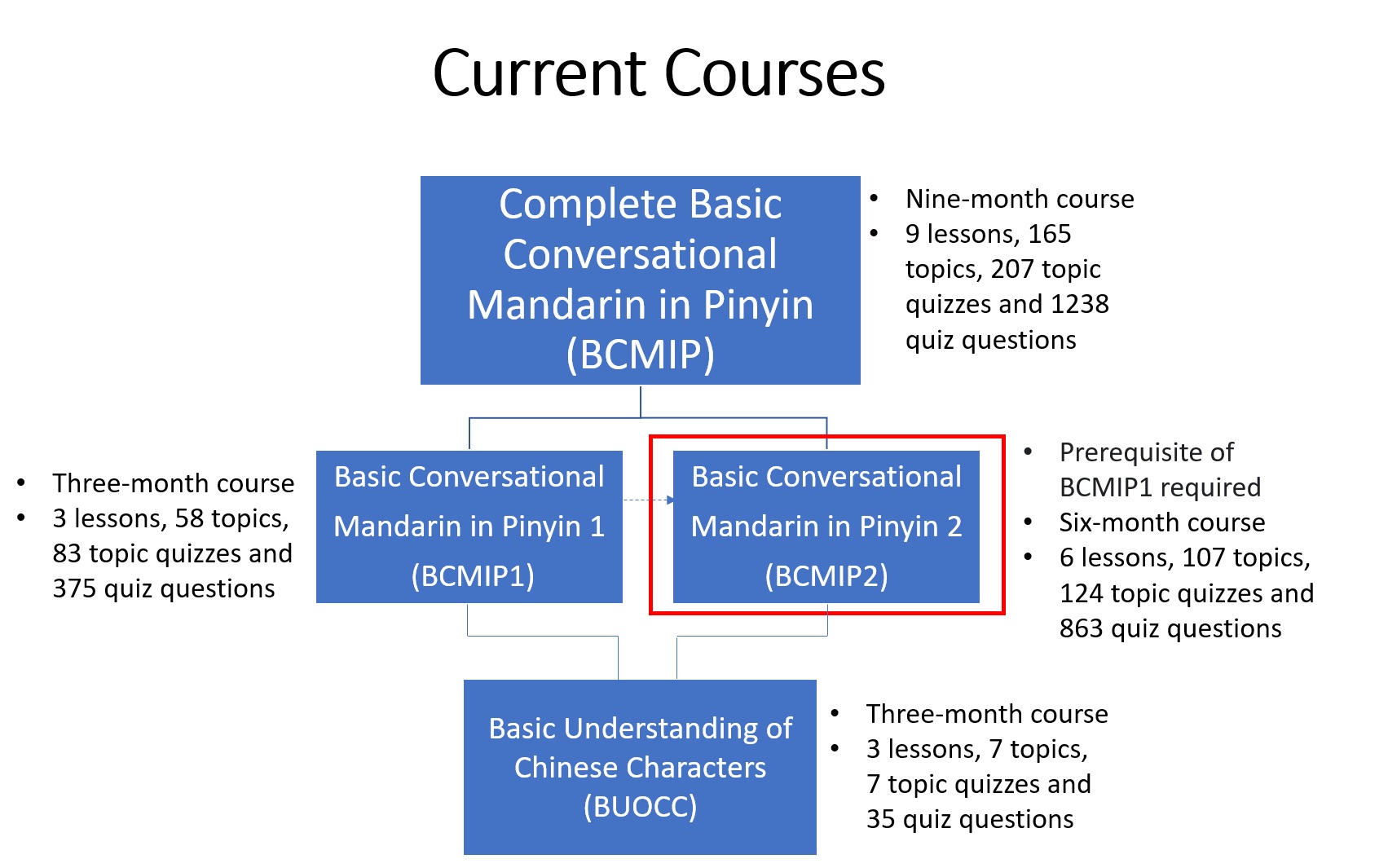
Note that BCMIP1 and BCMIP2 are sub-courses of BCMIP as depicted above.
Below are the combinations available:
- BMCIP1 followed by BUOCC
- BCMIP1 first, followed by BCMIP2 and BUOCC respectively
- Complete BCMIP course (BCMIP1 and BCMIP2)
- BCMIP1, BCMIP2 and BUOCC
- BUOCC as a standalone course if you already know Pinyin
Some recommendation after you have completed trials at BCMIP1 and BUOCC:
- If you are a beginner or someone who wants to improve your pronunciation, you can select BCMIP1.
- If you think you want to practice more on Pinyin or apply it in daily conversation without the need to learn Chinese characters, then you can select BCMIP2 after finishing BCMIP1.
- If you want to master Pinyin before proceeding to learning Chinese characters in BUOCC, then the Complete BCMIP course (BCMIP1will be your preferred choice as you will enjoy some cost savings compared to taking both BCMIP1 and BCMIP2 separately.
- You can sign up for the complete package of BCMIP1, BCMIP2 and BUOCC for maximum cost savings
There is no refund policy as you can try out the free lesson 1 trial to determine whether the course meets your expectations.
Do note that the main transaction currency for payment is US$. Alternatively, you can pay via Euro or Singapore Dollar. The methods of payment are:
- Paypal
- Credit Card via Paypal Platform
- Direct Bank Transfer via Internet Banking/PayNow (for Singapore-based customers only)
Singapore-based students will save the conversion fees by paying in SGD if they use Direct Bank Transfer mechanism. The exchange rate will be based on the data provided by Google Finance and updated once per day.
To select Direct Bank Transfer, click on the SGD icon on the Order Page as shown below:

You will see the course fee displayed in SGD as depicted below:

Do drop us a note at Contact LMS Page so that the School could liaise with you on the registration details. Such step is necessary to prevent spamming.
- The traditional method of learning Chinese: Pinyin + Character memorisation is difficult if you do not start from young. This is because the brains of mature learners whose mother tongues are Latin alphabet languages (phonograms) such as English, French, Spanish, German etc have difficulty to adapt to a system of phonograms (pinyin) + logograms (Chinese written characters) since their brains have been attuned to the Latin alphabet language system.
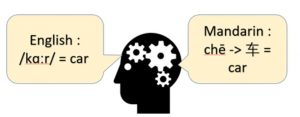
- Therefore, a good strategy of learning Mandarin is to master Pinyin first as this is similar to Latin alphabet languages & other languages which are sound-based. Once you have mastered Pinyin, then you can focus on Chinese characters. You will understand the importance of Pinyin as you need it to input Chinese characters if you are using a computer.
- The Pinyin method is also suitable for beginners who do not want to spend a lot of time and money to learn Mandarin as you can use it in common day-to-day scenarios. Also, some people are unsure whether Mandarin is too difficult for them and learning Pinyin first would help them to decide whether Mandarin is their cup of tea.
- In addition, if the students wish to proceed further in learning Mandarin, then they face an easier time by just focusing on the written characters next since they have overcome the hurdle of learning the pronunciation.
- Thus, the current Pinyin courses are structured to facilitate two groups of students:
- those who need the basics and would like to learn on their own after taking the BCMIP1 course
- those who want to improve further by taking up the practicum-focused BCMIP2 course.
- The course materials will have two versions i.e. one without Chinese characters and one with them. The student is advised to focus on the copy without Chinese characters and once he has passed the quizzes, he could concentrate on the copy with Chinese characters.
- Le Mandarin School will also have courses on Chinese Characters i.e. Basic Understanding of Chinese Characters (BUOCC) and the student is recommended to take up this course to have a good understanding of Chinese characters.
- For those who intend to take the Hanyu Shuiping Kaoshi (Chinese Proficiency Test), a complete list of Chinese characters associated with the Pinyin is provided. You will have the detailed information which include the meaning, grammar type, HSK category etc. A sample is shown below:

You will benefit from taking BCMIP courses from Le Mandarin School if you are:
- A beginner, either an adult or a teenager, who wants to learn Pinyin to understand Chinese pronunciation without incurring hefty fees.
- Someone who wants to learn Mandarin on his/her own. You cannot master Pinyin on you own as you need a teacher to guide you on your pronunciation. Once you have learnt Pinyin in this course, you will differentiate the similar sounds in Mandarin and avoid making embarrassing mistakes that are common for foreigners as they are new to a tonal language like Mandarin.
- A person who is unsure whether Mandarin is too difficult for them. Learning Pinyin i.e. the spelling sounds first would give him/her an idea before deciding to embark further.
- Someone who is busy and so a Learning Management System (LMS) is good as you can spend your idle time learning Mandarin. Examples of idle time are taking the subway, waiting for someone etc.
- Chinese Singaporeans who want to communicate effectively with Mainland Chinese or speak with their children/grandchildren to help them improve their Mandarin.
- Someone who wants to learn Mandarin but cannot find any school/teacher in the neighbourhood.
Lesson 1 Topics (T stands for Topic) This lesson serves to give the student an introduction to Chinese language and the tones.
- T1 – Understand the nature of Chinese Language
- T2 – Why Pinyin (Spelling Sound)
- T3 – Learn the Four Tones
- T4 – How to use Pinyin effectively
Lesson 2 Topics Lesson Two is a practicum-oriented topic as the student has to go through 30 topic videos and 53 quizzes before he/she can proceed to Lesson Three. The student is taught the traditional method of pronunciation and an alternative for those who prefer English-like pronunciation.
- T1 – English Proxy Sound Method for learning initials (An Alternative to Pinyin)
- T2 – Pinyin Pronunciation
- T3 – Practice
Lesson 3 Topics From this lesson onwards, the student will start to apply what they have learnt in Lessons 1-2. Simple Chinese grammar is also taught. The student is expected to say simple sentences like “I am an American”, “I am tall” etc.
- T1 – Vocabulary
- T2 – Basic word order (subject-verb-object)
- T3 – to be (shì)
- T4 – Adjectival verb
- T5 – yes-no question (ma)
- T6 – yes-no question (verb-not-verb)
- T7– Implied comparison
- T8 – Omitting known information
- T9 – Dialogue Practices
Do note that BCMIP1 is the prerequisite of BCMIP2.
Lesson 1 Topics Student will learn how to introduce himself/herself in this lesson. He/she will also learn how to pronounce numbers from one to ninety-nine. There is a Course Interim Quiz at the end of this lesson.
- T1 – Vocabulary
- T2 – Classifiers
- T3 – Demonstrative Pronouns (this, that)
- T4 – Numbers I (one to ninety-nine)
- T5 – Possession (de)
- T6 – Tag Questions
- T7 – Naming in Mandarin/How to introduce yourself
- T8 – Dialogue Practices
- Course Interim Quiz
Lesson 2 Topics Lesson 2 include topics such as model verb ‘can’ and common adverb dōu to the student. He/she will complete the lesson on numbers and know how to apply them in real life.
- T1 – Vocabulary
- T2 – Numbers II (Hundred bǎi, Thousand qiān, Ten Thousand wàn)
- T3 – Zero (Líng)
- T4 – How many?
- T5 – Modal Verb ‘Can’
- T6 – Common Adverb dōu (all/both)
- T7 – Choice Questions (hái.shi)
- T8 – Follow-up questions with ne
- T9 – Dialogue Practices
Lesson 3 Topics This topic is important as it focuses on money and prices which every foreigner will need to use them in daily life when they are living in China. We will also look at numerical expressions like bàn, duō etc.
- T1 – Vocabulary
- T2 – Money and Prices
- T3 – Unit price
- T4 – Half (bàn)
- T5 – Something plus (duō)
- T6 – Each /Every (měi)
- T7 – “Only” (zhǐ)
- T8 – Must (děi, negation – bùbì)
- T9 – Change in situation using le
- T10 – Dialogue Practices
Lesson 4 Topics This is another essential lesson as the student will get acquainted with the calendar expressions.
- T1 – Vocabulary
- T2 – Year, Seasons
- T3 – Months
- T4 – Days of the Month and Time Ordering
- T5 – Days of the Week
- T6 – Parts of the day
- T7 – Last, This and Next
- T8 – Ordinal Numbers
- T9 – Dialogue Practices
Lesson 5 Topics This lesson will wrap up the course by looking at time expressions and colours.
- T1 – Vocabulary
- T2 – Clock Time
- T3 – Common Time Expressions
- T4 – Completion Marker le
- T5 – Past/Present/Future
- T6 – Before/During/After of an action/event
- T7 – Verbal Duplication
- T8 – Colours
- T9 – Dialogue Practices
Lesson 6 Topics This is a summary lesson to highlight the important points in the course. The student will finish the course once he/she completes the Course Final Quiz.
- Summary of Key Points of this course
- Tips for self-learners who want to proceed further
- Course Final Quiz
Lesson 1 Student will learn the below topics:
- An introduction to the history of Chinese characters
- 11 basic Chinese strokes
- How to count no. of strokes
Lesson 2 This lesson will allow the students to understand the structures of Chinese characters which facilitate a building-block approach for easier memorisation.
- An introduction to Chinese characters
- Understand the written rules
- Learn the 13 structures for Chinese characters
Lesson 3 Students will be taught radical to aid memorisation and also how to use it in a dictionary:
- Radicals are taught in this lesson.
- Learn how to use radicals to find out the meanings and pronunciations of Chinese character using a hardcopy dictionary.
- An online dictionary is also taught to help students to harness useful features that are missing in the hardcopy dictionary.
Lesson 4 Student will learn the below topics:
- Learn how Chinese characters were created. Such understanding will help the student to focus on certain characteristics of Chinese characters to aid memorisation.
- Student will learn there are six types of Chinese characters.
Lesson 5 The topics are:
- Studying some common radicals to understand how students can leverage this aspect for their learning. The method is to teach the students to use radical as a visualisation tool which will be easier to understand and thus there is no need to do rote learning.
- One approach in this lesson is for the student to refer to oracle bone script of the radical which is pictorial and therefore facilitates learning.
- Another approach is for the student to use his/her imagination to adapt the radical for better memorisation.
- Learning Management System (LMS) is a software application for automation and delivery of educational courses and the Instructor is supported with tools in administration, tracking, reporting etc.
- As the content is recorded and posted online, you can access it anytime and so it is very flexible for the student. Because the instructor is not bogged down with teaching, he can spend his time productively with his students to focus on their issues in learning and monitor their progress.
- A pictorial form of LMS is shown below:

Each course has a long duration of a few months to cater for busy people such as working adults. Setting an expiry date will encourage the student to commit his/her time in learning and so they do not procrastinate which is often a problem with lifetime access for a course.
The students can also download the lesson materials which will be useful for them even after the course has expired.
Of course! The student will be given a Certificate of Completion upon successfully concluding the course. An example is shown below for the BCMIP course:
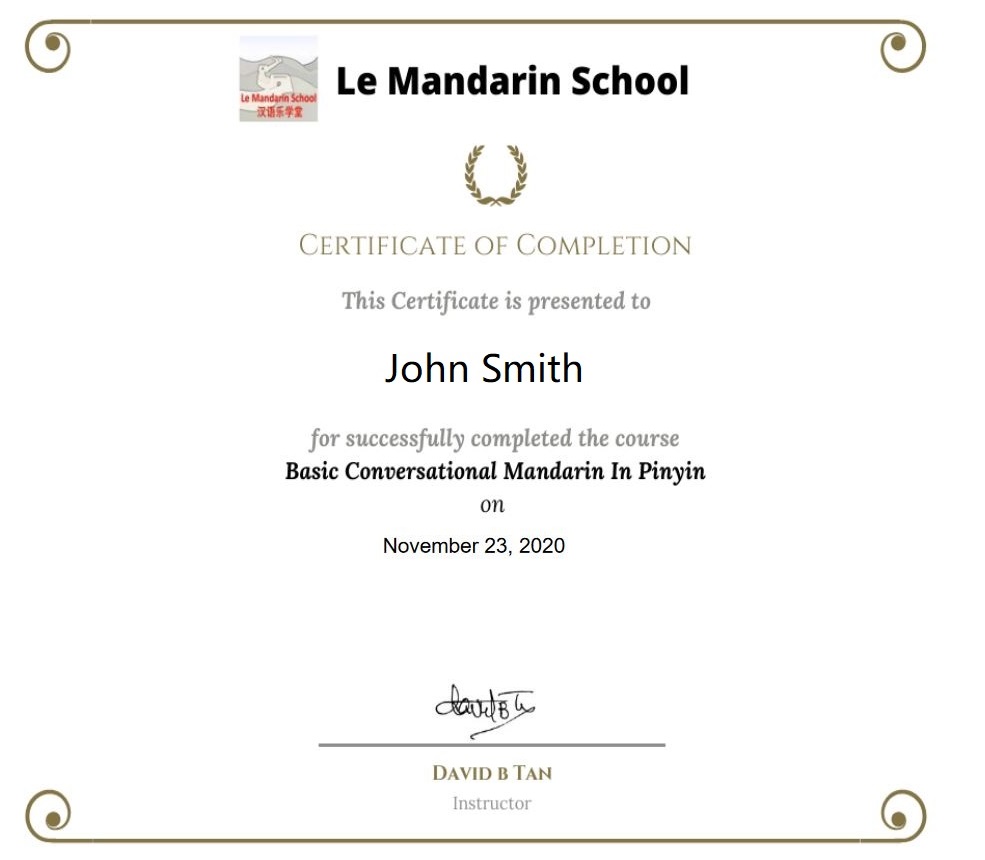
- Because the definition of e-learning course varies across countries, the Instructor i.e. David BK Tan wants to set the record straight here to avoid misunderstanding on the tax issue since Le Mandarin School (LeMS) courses can be purchased globally.
- To determine whether some e-learning courses do require taxes to be imposed, most countries would require such courses to be automatic, delivered electronically, and have no human interaction. Do note each LeMS course is not fully automated as the Instructor has to grade the essay questions himself. He also has to interact with the students through e-messages and discussion forums on lesson content and quizzes.
- To avoid any misunderstanding, the Instructor is highlighting why LeMS e-learning course does not qualify for digital tax in some countries that he is aware of:
EU
Please refer to EU’s explanatory notes https://ec.europa.eu/taxation_customs/sites/taxation/files/resources/documents/taxation/vat/how_vat_works/telecom/explanatory_notes_2015_en.pdf,
On page 88, it states that an e-learning course is taxable based on the below condition:
(5) Point (5) of Annex II to Directive 2006/112/EC: (a) Automated distance teaching dependent on the Internet or similar electronic network to function and the supply of which requires limited or no human intervention, including virtual classrooms, except where the Internet or similar electronic network is used as a tool simply for communication between the teacher and student; (b) workbooks completed by pupils online and marked in an automated fashion without human intervention
As there are teacher-student interactions in BCMIP and essay questions that are to be marked by the Instructor, so VAT is not imposed on EU students who purchase this course.
U.S.
Based on Streamlined Sales and Use Tax Agreement (SSUTA) adopted by 24 U.S. states, one condition states that “The sales tax is not applicable if the participant is evaluated by an instructor”. As there are essay questions in BCMIP that require the evaluation by the Instructor, so you need not pay tax if you are from one of the 24 states. The 24 U.S. states (23 full members and and 1 associated member) are Arkansas, Georgia, Indiana, Iowa, Kansas, Kentucky, Michigan, Minnesota, Nebraska, Nevada, New Jersey, North Carolina, North Dakota, Ohio, Oklahoma, Rhode Island, South Dakota, Tennessee, Utah, Vermont, Washington, West Virginia, Wisconsin, and Wyoming.
Regretfully, geographical restriction has to be imposed on the rest of the U.S. states not under SSUTA. This is because the collection of tax imposes a huge cost burden on Le Mandarin School and the business will be unsustainable in the short run.
Singapore
Do take note that the conditions of imposing digital tax are different in each country and they could change over time. For e.g., in the case of Singapore, overseas digital service providers with a yearly global turnover of more than S$1 million and sold more than S$100,000 worth of digital services to customers in Singapore are required to pay digital tax.
For Singapore residents who purchase this e-learning course, you need not pay GST as LeMS does not qualify as a GST-registered company.
In conclusion, if you are not residing in Singapore, do check on your country’s definition of e-learning course to determine whether LMS course is taxable or not. The Instructor is glad to discuss with potential students on this matter; do drop him a note in the “Contact LMS” page in this case. Thank you!
